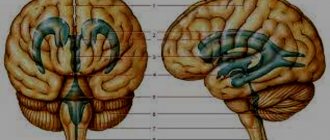The relevance of the problem of acute paraphrenic states is determined by their special position among psychopathological syndromes with a tendency, on the one hand, to periodic, and on the other hand, to continuous disease processes. Including in their structure most of the spectrum of positive psychopathological disorders in different proportions, they represent a kind of “slice”, “nodal point” [1] of the pathological process, expressing the qualitative features of a progressive disease in a given period of time.
In modern foreign literature, the term “paraphrenia” is used in relation to psychoses of late age and as a synonym for the chronic course of schizophrenia with the presence of systematized delusional symptoms [2-5]. Acute paraphrenic syndrome is not identified as a separate psychopathological definition in foreign literature, which is reflected in the modern classification of mental illnesses.
In the present study, within the framework of the psychopathology of acute paraphrenic syndrome, predominantly positive symptoms were studied, taking into account the characteristics of the course of schizophrenia.
The purpose of the study is to study the clinical and psychopathological structure and dynamics of acute paraphrenic states in various forms and variants of the course of schizophrenia.
Service price
- HOSPITAL Day hospital5 000
- Day hospital with intensive care8,000
- 24-hour hospital (all inclusive, cost per day) 12,000
- 24-hour hospital (all inclusive, cost per day). Single occupancy24,000
- 24-hour hospital (all inclusive, cost per day). Single occupancy in a superior room 36,000
- Primary family counseling for relatives of patients undergoing inpatient treatment free of charge
- Group psychotherapy for relatives of patients undergoing inpatient treatment free of charge
- Group psychotherapy for 24-hour and day hospital patients free of charge
- Individual post for a hospital patient (if indicated)6,000
Paraphrenia is a fantastic delirium of “particularly large scope”, combined with increased (rarely decreased) mood. A more severe form of delusion than paranoia and paranoid.
Patients feel like rulers of people, planets and the Universe, centers of the struggle between good and evil, sources or conductors of divine forces. Paraphrenic syndrome is an indicator of a gross disruption of the brain and psyche.
Paraphrenia literally means “beside the mind” in Greek. It was first described by the famous German psychiatrist Emil Kraepelin in 1907 as a separate disease. However, to date, this is not considered a separate disease, but is a syndrome (a combination of several symptoms) that can develop in various mental disorders.
Clinical picture
With paraphrenic syndrome, the following symptoms are observed:
- delusional ideas (persecution, overestimation of one's own importance);
- hallucinations or pseudohallucinations;
- behavior of a fictitious nature (communication with aliens or famous people);
- the patient does not try to convince others of his stories, he sincerely believes in his story;
- sudden mood swings, but rarely being depressed.
In addition, the patient may additionally develop Capgras syndrome, characterized by the presence of a double that replaces it. A person explains the reason for attributing bad deeds to him by the actions of his double or non-existent twin. With this pathology, the patient may not recognize people from his close circle and family, but can see a loved one in a stranger.
In general, symptoms of paraphrenia indicate the progression of mental illness and deterioration of the patient’s condition.
The following painful phenomena are characteristic of paraphrenia:
- A symptom of false recognition, when in unfamiliar people around them they see other, important persons participating in their lives.
- Fantastic delirium of grandeur.
- Increased mood (less often decreased), euphoria.
- Confabulations are false memories. The patient feels that he remembers certain events. However, in reality these events did not happen.
The causes of paraphrenia are gross disturbances of metabolic processes in the brain, overexcitation of subcortical structures.
Classification with clinical features
Depending on the characteristics of the symptoms, it is customary to distinguish several types of paraphrenic syndrome:
- Hallucinatory . The patient hears internal and external voices that instill in him delusional ideas and also distort reality. In this state, the patient rarely enters into dialogue with others, proving that he is right.
- Systematized . Ideas are sustainable. They are orderly, although they are delusional. This type of disease is characterized by pronounced delusions of grandeur, superiority and a negative attitude towards other people. This behavior is accompanied by both auditory and visual hallucinations.
- Confabulatory . The patient has a combination of inflated self-esteem and memories of non-existent events in which he took a heroic part. This type of disorder rarely goes away on its own. It usually occurs as a result of complications of hallucinatory and systematized paraphrenia.
- Depressed or melancholic . The patient unreasonably considers himself guilty of actions that he did not commit. He assures everyone that he deserves punishment and humiliation, and tries to blame himself at every opportunity.
- Erotic . It affects women more often. Usually the cause is problems in family life. It seems to the patient that he is being reproached for immorality (adultery) and is promised to be punished by resorting to sexual violence. The disorder is intermittent and occurs in attacks.
- Late . Diagnosed in people over 70 years of age. Patients feel that their rights are constantly being violated and offended. The pathology relates to senile schizophrenia and is practically untreatable.
Depending on the nature of the disease, acute and chronic forms of paraphrenia are distinguished. In the first situation, the disease occurs suddenly and has a pronounced change in behavior - from euphoria to depression, and vice versa. The delusion in this case is unsystematized and is usually described as particularly important (for example, saving the planet).
In the chronic course of the disease, delirium is stable and systematized. Delusions of grandeur prevail. There are no sudden changes in behavior. The patient perceives his thoughts as truth and does not enter into arguments.
Paraphrenic syndrome can be observed in the following diseases
- Organic mental disorders.
- Schizophrenia, schizoaffective disorder, other schizophrenia spectrum disorders.
- Atypical bipolar affective disorder.
According to the flow, acute and chronic paraphrenia are distinguished. Acute paraphrenia develops in a relatively short time and can be reversible. Chronic paraphrenia is difficult to treat and can last a lifetime.
To identify and make a diagnosis, the patient must be examined by a psychiatrist. Usually, a single examination by a doctor is enough to clarify the condition.
Treatment of paraphrenia should be carried out in a hospital. Therapy includes antipsychotic effects with drugs with anti-delirium action, and if ineffective, shock treatment methods. Other methods - physical therapy, psychotherapy, diet therapy - have an auxiliary effect.
As a rule, patients with paraphrenia, although not critical of their condition and not aware of their illness, do not resist hospitalization, perceiving what is happening as part of a “game” or performance that is played out around them. But in some cases they can resist and be aggressive. In these cases, involuntary hospitalization is required within the framework of Russian legislation.
If you encounter incorrect behavior in your loved one, do not waste time, contact a psychiatrist and arrange an examination of the patient. You can invite a psychiatrist to your home or go for a consultation yourself.
If you need help during hospitalization, contact us, we will help.
Material and methods
We observed 60 patients with schizophrenia, 29 women and 31 men aged from 20 to 54 years (average - 37 years) with a picture of acute paraphrenic states during an attack of the disease.
The duration of the disease in the studied patients was from 6 months to 35 years, the number of attacks suffered by one patient, including paraphrenic ones, was from 1 to 6. The total number of attacks in 60 patients was 164, of which 113 were acute paraphrenic, and 51 attacks of other types. .
The work used psychopathological, follow-up and statistical research methods.
Prevention
Prevention of the disease is necessary when there are prerequisites for the development of the syndrome. This could be a genetic predisposition, brain disorders, or even frequent conflict situations in the family.
To prevent the occurrence of an anomaly at a young age, it is first necessary to create a favorable environment for the child. Love, care, friendly relationships in the family and good upbringing automatically prevent the risk of developing a deviation. In some cases, the help of a psychotherapist may be needed. Such work can stop the progression of the disease even in its embryonic stage.
It is more difficult for an adult to prevent the occurrence of a disorder, but everything is still possible. To do this, you should avoid stress and conflict situations in the family and at the workplace; give up bad habits; walk in the fresh air and go out into the countryside as often as possible; try to eat rationally and correctly. Such simple techniques will also help improve the general condition of the body, increase efficiency, and also lift your mood.
Possible complications
Paraphrenic syndrome is one of the stages of the course of schizophrenia. Negative consequences in this condition are associated with the subsequent progression of the underlying disease and the development of the following complications:
- drug-resistant form of schizophrenia, characterized by a lack of effect from antipsychotics (with this type of disease, electroconvulsive therapy is possible);
- dementia against the background of degenerative processes in the cerebral cortex;
- persistent mental or neurological defect leading to a significant decrease in the level of quality of life and ability to work, the patient may become disabled.
In addition, the progression of paraphrenia poses a threat to the life of the patient himself and the people around him. Mental automatisms and delusions of persecution can push the patient to commit suicide or cause harm to the health of doctors, colleagues, relatives, etc.
Is it possible to warn?
The main method of prevention is timely diagnosis and treatment of the main provoking disease, as well as preventing the development of complications. The medical literature notes that the use of psychotropic drugs in the treatment of schizophrenia entails a reduction in the number of patients with paraphrenic syndrome.
In addition, the creation of a favorable emotional atmosphere plays a significant role in preventing the occurrence of this pathology. This should include the attention and care of parents for their children, the absence of quarrels in the family, visiting a psychologist, and avoiding conflict situations at work.
The use of psychotropic medications must be agreed upon with the attending physician. In addition, you should not succumb to the negative influence of others with suggestions about using drugs and alcoholic beverages.
Diagnosis and differentiation from similar disorders
The main task when examining a patient with suspected development of paraphrenic syndrome is to establish differences between similar disorders that indicate mental disorders.
Paraphrenia is considered the most complex form of delusional state. Therefore, special attention in this situation is paid to differential diagnosis.
The symptoms of paranoid, paranoid and paraphrenic syndrome are similar. Therefore, they can be distinguished from each other only after identifying all the pathological symptoms in the patient.
Thus, with paranoid syndrome, delusional ideas often arise against the background of a disturbance in the state of mind. With paranoid syndrome, a person exhibits suspicion and mistrust, which can subsequently cause persecution mania.
Paraphrenia should be distinguished from delusional states in adolescent psychosis or mental disorders as a result of taking psychotropic and narcotic drugs. Therefore, it is important to establish the duration and nature of the symptoms that occur.
With paraphrenia, real things are replaced by fantastic ideas, while brain functions are not impaired. Therefore, this pathology is excluded from the doctor’s consideration if problems are detected during a neurological examination of the brain.
Paraphrenic syndrome is not classified as a separate painful condition.
For this reason, it is necessary to establish the disease that accompanies the corresponding symptoms and treat it, and not individual manifestations of paraphrenia.
Stages
Paraphrenic syndrome can act as one of the stages of various mental disorders. Experts include such deviations:
- Acute paraphrenia. The disorder is manifested by frequent bouts of delirium. The trigger for pathology is recent changes in a person’s life that bring significant inconvenience. In this case, the syndrome manifests itself as schizophrenia or symptoms of acute psychosis.
- Fantastic paraphrenia. This state is characterized by the ideas of omnipotence, power, greatness and wealth. The patient may experience hallucinations and partial loss of orientation in space.
- Chronic paraphrenia. Monotony of speech, a rather meager vocabulary, incoherent expressions and phrases, human lethargy - such symptoms are the main sign of this type of disorder.
Symptoms
Paraphrenic syndrome has a wide range of symptoms and manifests itself individually in each new case. It is believed that among the first three main signs of the disease are the presence of:
- Hallucinations, pseudohallucinations - the patient sees next to him unreal images of non-existent characters, talks about fantastic events taking place in his life that are completely divorced from reality.
- Mental automatism, suggesting that the patient’s own thoughts and actions are recognized as inspired by society. The disorder occurs simultaneously with delusional disorder.
one of the symptoms of paraphrenic syndrome: delusions of grandeur
Delusional ideas, including delusions of grandeur and persecution, when the patient regularly feels the participation of other people in his life (imaginary illusion).
Patients with paraphrenia become especially noticeable compared to healthy people when they are euphoric and very happy about something. It is at such moments that they consider themselves real rulers of the entire Universe and are capable of any action. During an attack of the disorder, patients may feel like famous writers or outstanding scientists. Some attribute to themselves such fantastic traits and unrealistic superpowers that they themselves cannot understand who they are. Along with this, hallucinations arise.
Speech also gives away a person with paraphrenia. She is solemn, commanding, emotional. She is able to inspire confidence in other people, convincing everyone that she is right, and also call on others to take decisive action. At the same time, delusional ideas are often supported by the statements of great classics and quotes from literature.
Those who are ill are constantly preparing for an upcoming grandiose event known only to them, for example, the impending end of the world or an alien invasion. Such unrealistic stories each time acquire new characters and increasingly rich colors. In addition, the patient begins to sincerely believe that his life is protected by real heroes, who once again emphasize his importance and increase self-esteem.
Quite often, the main symptom of paraphrenia is the delusion of a negative double, which was first described by Kapgrom. The patient believes that his close relative, or himself, has been replaced by an invisible double and it is he who commits all the negative actions. Over time, a person begins to get confused in personal relationships, not understanding who is a relative and who is a stranger.
Treatment
Complete recovery of a patient with paraphrenia is only possible if a specialist has thoroughly studied the patient’s medical history and learned about all the manifestations of the syndrome. This is especially important because the pathology manifests itself individually in each person, which means that in each new case it requires a special approach. For example, even the emotional state of patients can differ significantly: one arrives in constant euphoria, another complains of a depressive disorder.
Almost all patients are prescribed antipsychotics, which help cope with psychotic disorders: get rid of suspiciousness, increased excitability, hallucinations and delusional disorders. Preference is given to the group of atypical antipsychotics “Ketilept”, “Servitel”, “Rispolpt”. Since most patients forget to take medications, specialists can prescribe long-acting medications.
The remaining signs of the disease should be treated individually, depending on the frequency and strength of their manifestations. For example, patients with depressive disorder need to take antidepressants Doxepin, Paroxetine, Melitor and psychotherapy sessions.
Treatment of the syndrome can be carried out both outside a medical institution and in a hospital. It is worth saying that complete recovery of a sick person in old age is almost impossible, since all mental changes usually become irreversible.
Forecast
The prognosis is favorable. With timely detection of the disease and the prescription of complex treatment after the first manifestations of paraphrenia, recovery is observed in 85-90% of patients. Subsequent anti-relapse therapy for six months minimizes the risk of exacerbation.
The prognosis worsens when the condition recurs. With 3 or more exacerbations, complete recovery is impossible. Such patients require lifelong treatment with antipsychotics. If you refuse them due to provoking factors, the symptoms of paraphrenia return.
In the absence of treatment or its improper implementation, schizophrenia progresses. It can lead to severe mental or neurological defects. Therapy in this case does not improve the condition and recovery.
Forms
In psychiatry, paraphrenic syndrome is usually divided into several types:
- Systematized paraphrenia. He is distinguished by regular attacks of delusional ideas and special confidence in his own greatness and superiority. The patient also believes that he has his own double, who commits all negative actions.
- Hallucinatory paraphrenia. It is characterized by the fact that the patient constantly sees unreal characters and is in a fictitious place. Moreover, he is completely sure that all mythical heroes really exist.
- Confabulatory paraphrenia. A condition that develops against the background of two previous types of syndrome. The sick person is disturbed by delusions of grandeur along with false memories of his own exploits and actions.








